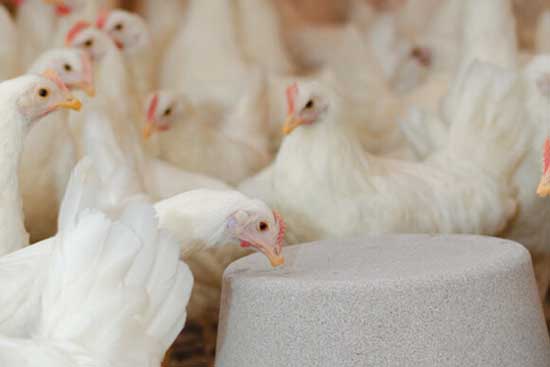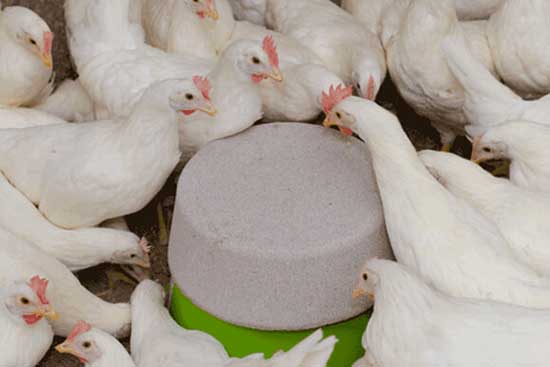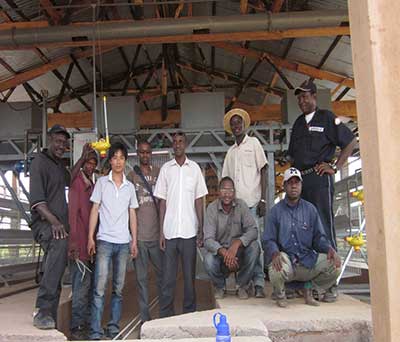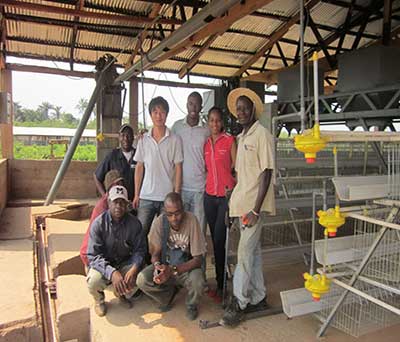Chicken Pecking Blocks Introduction
In commercial poultry farming, chickens do not need to forage for food as feed is readily supplied. However, the lack of foraging behavior can lead to what is known as the “redirected foraging theory”—where chickens develop harmful pecking behaviors, such as feather pecking, due to unmet foraging needs. These harmful behaviors can cause problems like poor feather condition, reduced thermoregulation, injuries, and in severe cases, death. Feather pecking is a significant animal welfare concern.
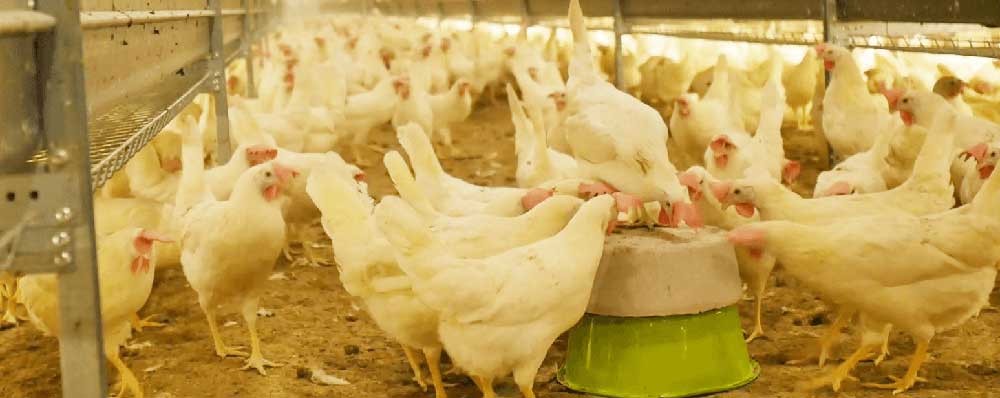
To address this issue, Canada now requires foraging enrichment for laying hens. Modern enriched cages include features such as perches, scratch mats, nesting areas with curtains, and feeders, supporting natural behaviors like nesting, roosting, and foraging. Among these, scratch mats encourage foraging behavior, but harmful pecking still occurs in enriched cages, indicating that additional substrates are necessary to further enhance foraging behavior.
An alternative enrichment strategy is the use of pecking blocks. These are specially designed blocks made of feed or mineral supplements aimed at satisfying chickens’ natural pecking and exploration needs while reducing abnormal behaviors such as feather or vent pecking. Pecking blocks, made from safe and edible materials, combine nutritional supplementation with behavior improvement. They are commonly used in cage-free systems (e.g., large aviary systems) and have proven effective in reducing harmful pecking and improving feather quality.
Uses of Chicken Pecking Blocks
Poultry Farming Feeding Equipment
Chickens require various nutrients like calcium and phosphorus during growth. Pecking blocks often contain minerals, vitamins, and other nutrients such as limestone, salt, grains, and plant extracts. They meet nutritional needs while encouraging pecking behavior to promote healthy bone development. For laying hens, pecking blocks provide essential calcium to prevent soft-shelled eggs.
Behavioral Correction
Chickens have an innate pecking instinct. In dense farming or welfare systems, lack of sufficient pecking objects can lead to undesirable behaviors like feather or vent pecking. Pecking blocks serve as a suitable target for pecking, reducing these harmful behaviors and lowering the risk of injuries. They help divert attention, promote welfare, and alleviate stress during events such as molting, environmental changes, or transportation.
Ingredients in Pecking Blocks
- Mineral-Based Blocks: Contain calcium, phosphorus, and salt, suitable for laying hens to improve eggshell quality. Common ingredients include calcium carbonate (a primary calcium source) and dicalcium phosphate for phosphorus supplementation. These are scientifically balanced for different growth stages.
- Vitamin-Enriched Blocks: Some blocks include vitamins like Vitamin D, which aids in calcium and phosphorus absorption, promoting bone growth and physiological function.
- Other Additives: Flavor enhancers such as salt to improve palatability. Preservatives to prevent mold during storage. Grains or plant components for additional energy and nutrition. Some blocks include herbal extracts or fragrances to relieve stress or medicated additives to combat parasites or promote health.
Chicken Pecking Blocks Shapes and Usage
Generally, a pecking block is in block-shapeed and has different sizes. Common shapes include cubes, cylinders, etc., and their size is designed according to the breed and growth stage of the chicken. For example, for chicks, the chicken pecking block will be relatively small to facilitate them to peck; while for adult chickens, the size of the chicken pecking block can be larger.
Blocks are placed where chickens can easily access them, either suspended from walls, placed on the ground, or fixed near perches. Ensure they are positioned to avoid contamination from droppings. Replace consumed or dirty blocks regularly to maintain hygiene and consistent nutrient supply.


Applications in Different Farming Systems
Cage Free Chicken House
In the cage free chicken house, the pecking block can be placed directly on the ground or fixed on a lower bracket that the chicken can easily reach. This kind of chicken house is generally open and the chickens can move freely. The chicken breeds raised are usually broilers or laying hens. Because the chickens have enough space to move around, they can peck at the pecking block at any time, and at the same time, they can meet their needs of exploring the environment and performing natural behaviors during the pecking process.
Semi-open Chicken Cage
The semi-open chicken cage such as an enriched cage, has a partially open space, combining the characteristics of indoor and outdoor environments. The pecking block can be placed in the corner of the indoor part, on the fixtures on the wall, or in the appropriate position of the outdoor activity area. For example, some free-range chicken farms use semi-open chicken cages, where chickens can go outdoors during the day, and the pecking block can be placed near the passage for chickens to enter and exit the cage or under the outdoor awning. Chickens raised in this kind of chicken cage can easily peck at the pecking block to supplement nutrition when entering and exiting the cage or in the semi-open activity area.
Multi-layer Aviary System
For a multi-layer aviary system, the pecking blocks need to be placed in places where the chickens can easily reach on each layer of the cage, such as next to the trough or on a specially designed pecking rack. Usually used for laying hen farming. Due to the relatively compact space, it is necessary to ensure that the placement of the pecking blocks will not affect the normal activities and feeding and drinking behaviors of the chickens, and to ensure that each layer of chickens has an equal opportunity to peck at the pecking blocks to meet their needs for nutrients such as minerals.
Pecking blocks are gaining importance in modern farming, especially in regions with high animal welfare standards such as the EU, the US, and Japan. Consumer demand for high-welfare eggs and poultry products has driven the adoption of such enrichment tools.
For farmers, pecking blocks help reduce losses caused by pecking injuries, improve production efficiency, and enhance the quality of eggs and meat. By fulfilling chickens’ natural behavioral needs, pecking blocks support better welfare and health, making them an essential tool in modern poultry farming.




Factors Influencing the Market Demand for Pecking Blocks
Development of the Poultry Industry
The scale of Poultry Farming: The size of poultry farming operations directly determines the demand for pecking blocks. As the demand for poultry eggs and meat increases, the growth in poultry farming and the rise of large-scale farming enterprises will drive a corresponding increase in the market demand for pecking blocks.
Shift in Farming Methods: Modern poultry farming increasingly emphasizes precision management and animal welfare, transitioning from traditional free-range systems to large-scale, intensive farming. Under this trend, farmers are likely to demand more pecking blocks to improve poultry productivity and welfare, reducing injurious pecking and enhancing farm profitability.
Product Characteristics
Nutritional Content and Quality: The richness, balance, and reliability of the nutritional content in pecking blocks significantly influence purchasing decisions. Products that provide high-quality protein, minerals, vitamins, and consistent quality are better able to meet the growth and production needs of poultry, leading to higher market demand.
Product Diversity: The availability of various types and functionalities of pecking blocks also affects demand. Beyond the standard nutritional supplements, products enriched with probiotics, herbal additives, or other health-promoting ingredients can cater to diverse health management needs of poultry, expanding the market space.
Market Competition
Brand and Reputation: Well-known brands typically offer better guarantees in terms of quality, effectiveness, and after-sales service, making them more trusted by farmers. Positive word-of-mouth recommendations among farmers can enhance the market influence and demand for such products.
Price and Cost-effectiveness: Farmers consider both price and cost-effectiveness when choosing pecking blocks. Competitive pricing and better quality and service at similar price points can enhance a product’s market competitiveness, stimulating demand.


Policies and Industry Standards
Supportive Farming Policies: Government support for the poultry farming industry, such as subsidies or technology promotion, indirectly impacts the demand for pecking blocks. Policies encouraging standardized and large-scale poultry farming may drive farmers to invest more in auxiliary products, including pecking blocks.
Product Quality Standards: Strict product quality standards and regulatory requirements help standardize the market, ensuring product stability and reliability. Products meeting these standards are more likely to be accepted, boosting market demand.
Consumer Awareness and Marketing
Farmers’ Awareness: Farmers’ awareness and understanding of pecking blocks directly affect their willingness to purchase. Enhanced education and outreach efforts can increase recognition of the benefits and value of pecking blocks, thereby driving demand.
Marketing Efforts: Producers’ promotional activities, such as advertising, technical training, and participation in exhibitions, can improve product visibility and market penetration, increasing demand. Effective marketing efforts help introduce pecking blocks to more farmers, driving market growth.
Macro-economic Environment
Economic Development Levels: During periods of economic growth, increased consumer demand for poultry products drives the poultry industry, subsequently boosting demand for pecking blocks. Conversely, economic downturns may adversely affect the poultry market, reducing demand for pecking blocks.
Raw Material Price Fluctuations: The production of pecking blocks requires various raw materials, such as minerals, vitamins, and grains. Fluctuations in raw material prices affect production costs and product pricing, which in turn influence demand. Rising raw material prices may lead to higher product prices, potentially reducing usage and impacting demand.

